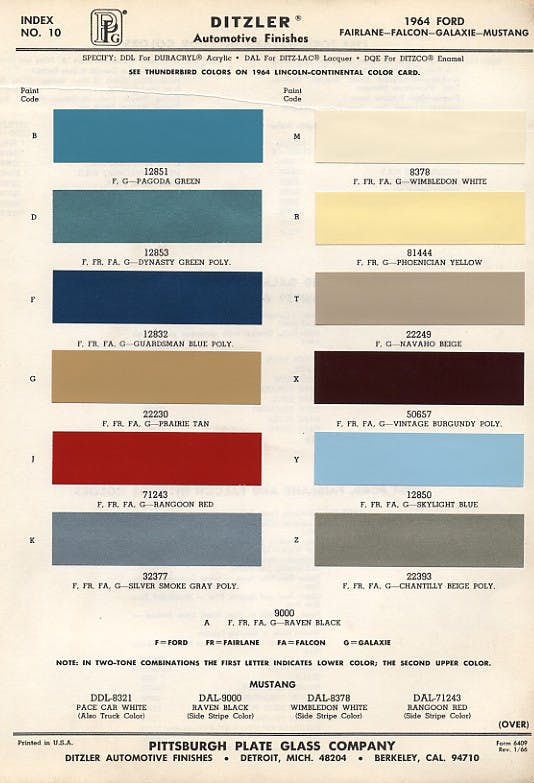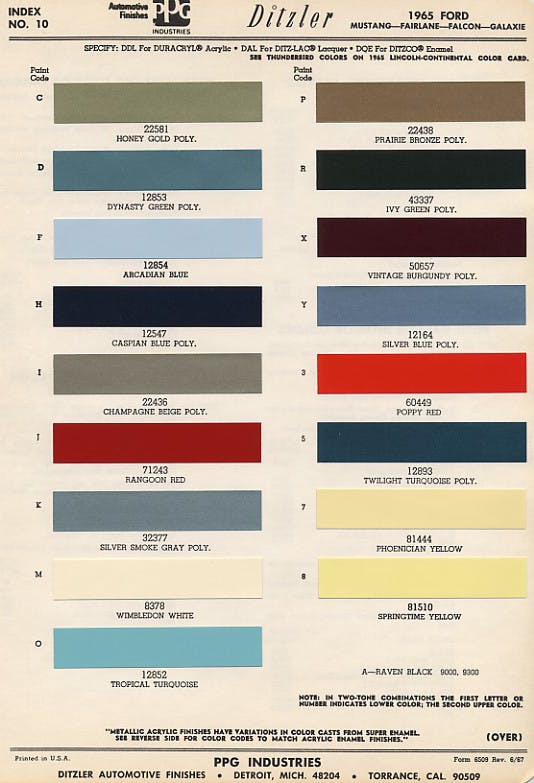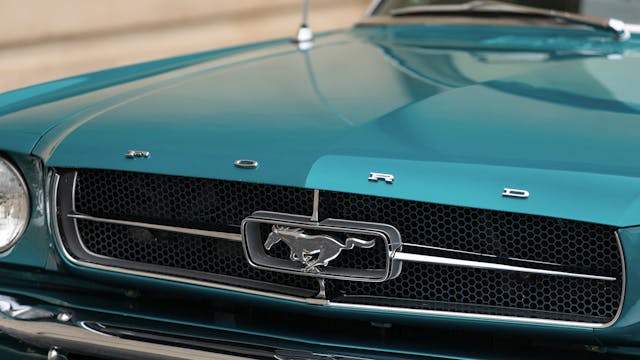Which Original Mustang Paint Color Is Worth the Most?
April 17 marks sixty years since the Ford Mustang’s public debut at the 1964 New York World’s Fair. The original pony car immediately became a pop-culture and automotive phenom, and it remains one of the most impactful cars in history. We’re celebrating with stories of the events surrounding the Mustang’s launch, the history of the early cars, and tales from owners. Click here to follow along with our multi-week 60 Years of Mustang coverage. —Ed.
When the Ford Mustang debuted sixty years ago at the World’s Fair in New York on April 17, 1964, it became an overnight hit. However, though Ford accurately targeted the up-and-coming baby boomer generation with the car’s avant-garde design and features, the Mustang wore many colors that were more ’50s pastels than ’60s shock. The discrepancy between the car’s image and its colors has complicated the picture for Mustang enthusiasts ever since. Many owners have opted to repaint their Mustangs, while others have sought cars painted in a rare, original shade. Which original colors are most likely to be covered with a repaint, and which original colors are most valuable? Read on.
For the 1965 model year, the Mustang was available in 24 colors (a few, like Pagoda Green, were only available on the 1964 ½ cars). Yellows, golds, blues, turquoises, beiges, reds, and greens were available, along with more common colors like black, white, and silver.


Some of the original colors aren’t especially valued by enthusiasts today—specifically, Silver Smoke Gray and Silver Blue. To reach that conclusion, we reviewed auction data from over 700 sales, going back to 2014, and compared those results to condition-appropriate values from the Hagerty Price Guide, whether the car in question was a six-cylinder or a K-code, a notchback or a convertible. We found that Silver Blue is worth just 5 percent more on average, and Silver Smoke Gray just 8 percent more.

Rarely seen or ordered, Prairie Bronze is worth nearly one-third less on average, and so is Sunlight Yellow. Vintage Burgundy is popular (almost 50 out of the 700 cars in our data set wore it) but typically worth 16 percent less on average. Conversely, Wimbledon White is relatively common (almost 40 transactions) but worth 16 percent more. Twilight Turquoise isn’t as common (about 20 sales), but worth 19 percent more. Dynasty Green is rare, with just three sales in the past ten years, and worth 24 percent more. A car wearing its original Raven Black is also worth a lot, despite being somewhat common (15 sales): This color is worth nearly 30 percent more on average. The prize for the most valuable color goes to the rarely seen, 1964 ½-only Pagoda Green, worn by only one car out of the 700: This color is worth 61 percent more.
If we group together all the colors, whether original or not, we see that yellows are worth the least on average, followed by reds and blacks, which are very common. However, white is more valuable on average, even though it’s frequently used, and so are orange, turquoise, and green. Gold, blue, green, and silver are in the middle.

What original Mustang colors are most likely to be painted over? Surprisingly, Wimbledon White: Though it is worth 16 percent more than other original colors, on average, it is replaced by a different one almost 75 percent of the time in our data set. Silver Blue, Silver Smoke Gray, Honey Gold, and Prairie Bronze are painted over nearly as often. Given the popularity of red in our dataset (150+ transactions), Poppy Red and Rangoon Red are rarely swapped out. Valuable Raven Black is also rarely painted over, as are Ivy Green and Twilight Turquoise.

What colors do owners typically use for a repaint? Red is the most popular shade, picked almost one-third of the time. It is followed by blue, white, black, and silver. Though Wimbledon White is often painted over, it is also occasionally picked as a repaint shade.

Which 1965-model-year Mustang color is most valuable to you?
***
Check out the Hagerty Media homepage so you don’t miss a single story, or better yet, bookmark it. To get our best stories delivered right to your inbox, subscribe to our newsletters.



I think the question was 1965 model year color……Grabber Green was not 😁👍
My ’69 Mustang Fastback is Royal Maroon and people really seem to like it. I think it looks great on that body style for sure.
One of my biggest gripes about cars today is that no manufacturer offers their cars in multiple colors. I am sick of white, black, gray, and silver cars. Can you imagine a manufacturer today offering a specific model in 24 different colors.
You’d think the color that’s ” rarely seen or used” would be worth more! Not less.
Well, sometimes it’s rarely seen or used because just a few people with no taste actually ordered one. To each his or her own, but Prarie Bronze has no business being on a Mustang.
–The Original Tim
A good body shop can replicate any of the colors. Or do your own custom.
If you pull up any of the original TV adds on the early models, they are almost all in prairie bronze.
As classic and expected it is to see a red Mustang, I’m surprised that color doesn’t at least hit average value. Perhaps because supply is so much greater?
Emberglow metallic was a 1966 color for one year only. It did not sell well but I liked the color
Went from Wimbledon White to Phoenician Yellow (the softer one) on my 64.5. (looks righteous with black interior).I get lots of positive comments but I realize just as many are just biting their lip, being polite cause they don’t care for any yellow. Did what I want and its a mid 60s shade that revs up nostalgia even with Chebbie and Mopar guys.
I think nothing looks nicer on a 1st generation Mustang than the color red. My 641/2 convertible was a real head turner back in 1975. One of the few cars I wish I still had.
ivy green
I admit I am not a fan of some of the fringie colors that some manufacturers have had throughout history. The Mustang is no different. I suspect it may be to offset Henry Ford’s fetish with black and that being the only color available in the early years. I can say that when I show my modern classic Mustang GT in Performance White (with the classic blue LeMans stripes), it does quite well at car shows when competing against other Mustangs in the class. I am also a believer that keeping a car the original color is just as important as keeping the proper drive train. Sorry LS fans, but those only belong in GM vehicles.
Candy Apple Red 1966 color for the convertible…iconic!!
My wife inherited a 64 and half convertible prairie bronze originally but she wants to paint it red
I wish they’d included 66 data in this, if nothing else to see how Emberglo fared.